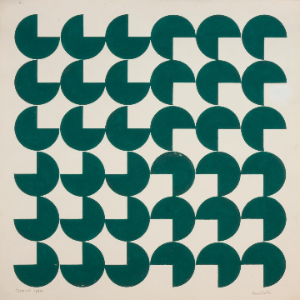Luiz Sacilotto was known for his versatile artistic production, which encompassed abstract paintings, geometric sculptures, and innovative collages. In addition to his completed works, the artist's studies and works in progress are also valued and often included in archives and private collections dedicated to him. These studies are fundamental pieces for understanding Sacilotto’s evolution and creative approach, offering valuable insights into his artistic process.

Source: Facebook - [url=https://www.facebook.com/luiz.sacilotto]https://www.facebook.com/luiz.sacilotto[/url]
In this study by Luiz Sacilotto, we can observe the repetition of certain geometric shapes as well as the presence of geometric transformations. Which geometric shapes do you identify in this study?
Which geometric transformations do you identify in this study?
Rotation and Translation.
In GeoGebra, using the [b]Rotate [/b]and [b]Translate [/b]commands, it was possible to create a reinterpretation of this study by Sacilotto.[br]Interact with the activity below to understand when these commands were used.[br]Follow the steps provided:[br][br][list=1][*]First, create sectors 2, 3, and 4 based on the sector already placed on the screen.[/*][*]Then, by applying translations, complete the reinterpretation of the artwork.[/*][/list]
To create this activity, the [i]Rotate[/i] and [i]Translate[/i] commands were used in combination with the [i]Button[/i] tool. This demonstrates one way to utilize the GeoGebraScript language.[br]The necessary commands for performing translations and rotations were inserted in the [i]Scripting[/i] tab of each button.
[list=1][*]Initially, a circular sector was created with center at point [i]C[/i] and endpoints at points [i]D[/i] and [i]E[/i], using the command: [code]Sector(Center, Point, Point).[/code][/*][*]Once the first circular sector was created and named [i]c[/i], the remaining sectors were obtained through translation and rotation. To achieve this, directional vectors were created to indicate the required translations: [i]u[/i] and [i]v[/i], where [i]u[/i] represents the horizontal direction, [i]v[/i] represents the vertical direction, both vectors have a magnitude equal to the diameter of the circular sector.[/*][*]For the [b]Setor 2[/b] button to translate the first sector after a 90° rotation about its center, the following command was inserted in the [i]Scripting[/i] tab of the button: [code]d=Translate(Rotate(c,-90°,C),3v)[/code]. [/*][*]For the [b]Setor 3[/b] button, the following command was inserted: [code]e=Translate(Rotate(c,-180°, C),3v + 3u)[/code]. [/*][*]For the [b]Setor 4[/b] button, the following command was inserted: f[code]=Translate(Rotate(c,-270°,C),3u)[/code].[/*][/list]
Explain what the command [code]d=Translate(Rotate(c,-90°,C),3v)[br][/code] does.
The original circular sector [i]c[/i] was rotated 90° clockwise around its center [i]C[/i]. After that, the new sector was translated 3 units upward ([i]3v[/i]), resulting in sector [i]d[/i].
Explain what the command [code]e=Translate(Rotate(c,-180°,C),3v+3u)[br][br][/code] does.
The original circular sector [i]c[/i] was rotated 180° clockwise around its center [i]C[/i]. After that, the new sector was translated 3 units upward and 3 units to the right ([i]3v+3u[/i]), resulting in sector [i]e[/i].
Explain what the command [code]f=Translate(Rotate(c,-270°,C),3u)[br][/code] does.
The original circular sector [i]c[/i] was rotated 270° clockwise around its center [i]C[/i]. After that, the new sector was translated 3 units to the right ([i]3u[/i]), resulting in sector [i]f[/i].
[list=1][*]After creating the four circular sectors, translations were applied to these sectors to complete the reinterpretation. To achieve this, four additional buttons were created.[/*][*]In the [i]Translation Sector 1[/i] button, in the [i]Scripting[/i] tab, the following commands were inserted:[/*][/list][*][code]c_1=Translate(c,u)[br][/code][/*][*][code]c_2=Translate(c,2u)[/code][/*][*][code]c_3=Translate(c,v)[/code][/*][*][code]c_4=Translate(c,2v)[/code][/*][*][code]c_5=Translate(c,u + v)[/code][/*][*][code]c_6=Translate(c,2u + 2v)[/code][/*][*][code]c_7=Translate(c,u + 2v)[/code][/*][*][code]c_8=Translate(c,2u + v)[/code][/*]
Explain each command inserted in the Translation Sector 1 button.
All the translations considered the circular sector [i]c[/i], which is a rotation of the original circular sector. Each new sector was named in a way that links it to this sector.[br]The command [code]c_1 = Translate(c, u)[/code] indicates the translation of circular sector [i]c[/i] (Sector 2) in the direction of vector [i]u[/i].[br]The other commands follow a similar logic.
What should the commands be for the Translation Sector 2 button?
[code][/code]Suggestion: use the nomenclature [code]d_{x}[/code] for each new sector.[br][br][code]d_{1}=Translate(d,u)[br]d_{2}=Translate(d,2u)[br]d_{3}=Translate(d,v)[br]d_{4}=Translate(d,2v)[br]d_{5}=Translate(d,u+v)[br]d_{6}=Translate(d,2u+2v)[br]d_{7}=Translate(d,u+2v)[br]d_{8}=Translate(d,2u+v)[br][br][/code][br][list][/list]
What should the commands be for the Translation Sector 3 button?
[code]e_{1}=Translate(e,u)[br][/code][code]e_{2}=Translate(e,2u)[br][/code][code]e_{3}=Translate(e,v)[br][/code][code]e_{4}=Translate(e,2v)[/code][br][code]e_{5}=Translate(e,u+v)[br][/code][code]e_{6}=Translate(e,2u+2v)[br][/code][code]e_{7}=Translate(e,u+2v)[br][/code][code]e_{8}=Translate(e,2u+v)[br][/code]
What should the commands be for the Translation Sector 4 button?
[code]f_{1}=Translate(f,u)[br][/code][code]f_{2}=Translate(f,2u)[/code][br][code]f_{3}=Translate(f,v)[/code][br][code]f_{4}=Translate(f,2v)[/code][br][code]f_{5}=Translate(f,u+v)[br][/code][code]f_{6}=Translate(f,2u+2v)[br][/code][code]f_{7}=Translate(f,u+2v)[br][/code][code]f_{8}=Translate(f,2u+v)[/code]
Justify why an error occurs in the execution of the programming when clicking any of the translation buttons before clicking the buttons to create sectors 2, 3, or 4.
The error occurs because the circular sectors [i]2[/i], [i]3[/i], and [i]4[/i] have not been created yet. The translation buttons rely on these sectors being already defined and available in the GeoGebra environment. When attempting to execute the translation commands before creating these sectors, GeoGebra cannot reference objects that do not exist yet, resulting in an error. Therefore, the creation of the sectors must precede the use of translation buttons.
Following the same reasoning for construction presented here, create an activity to reinterpret Sacilotto's study using GeoGebra Online by accessing the link [url=https://www.geogebra.org/classic]https://www.geogebra.org/classic[/url]

